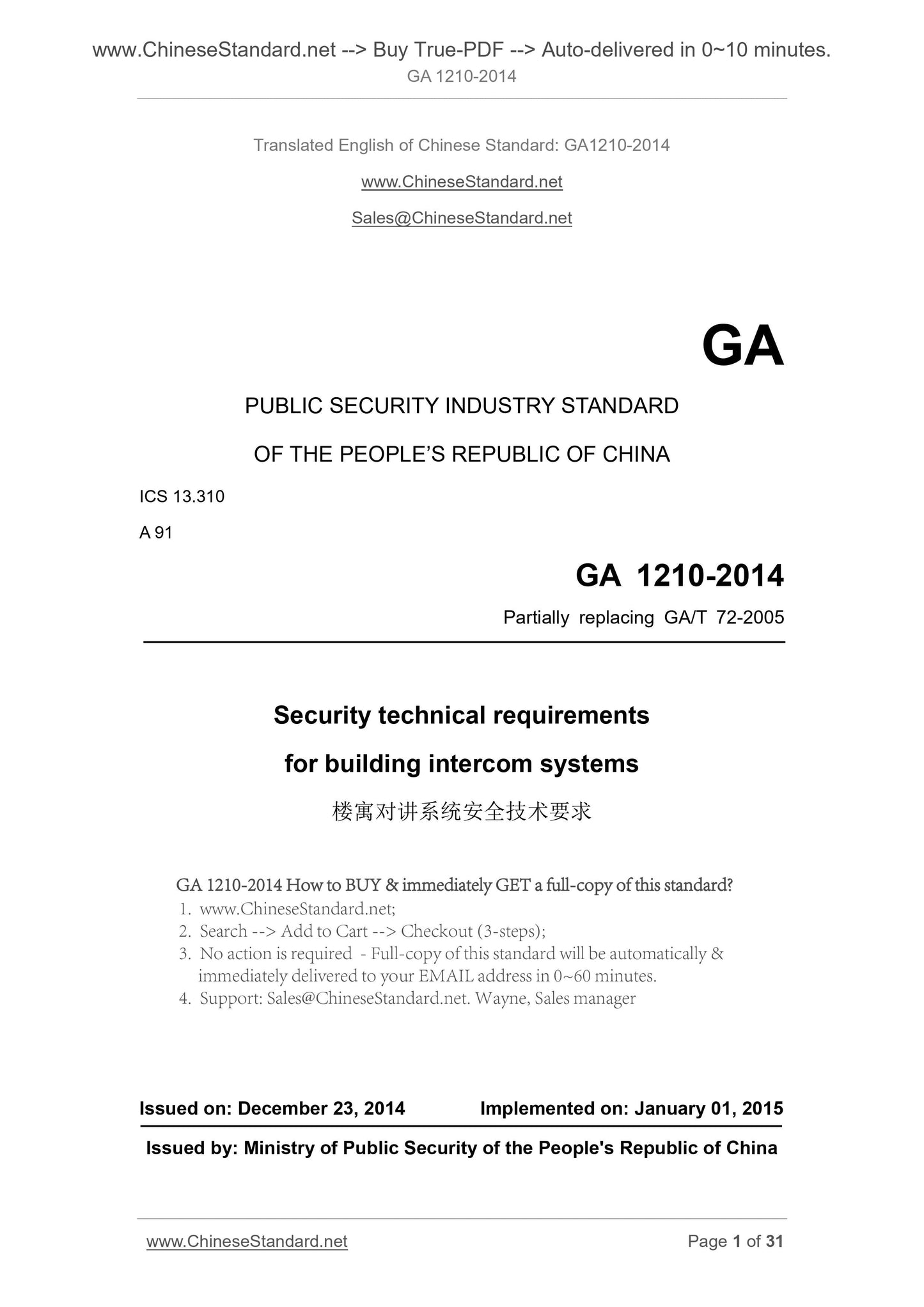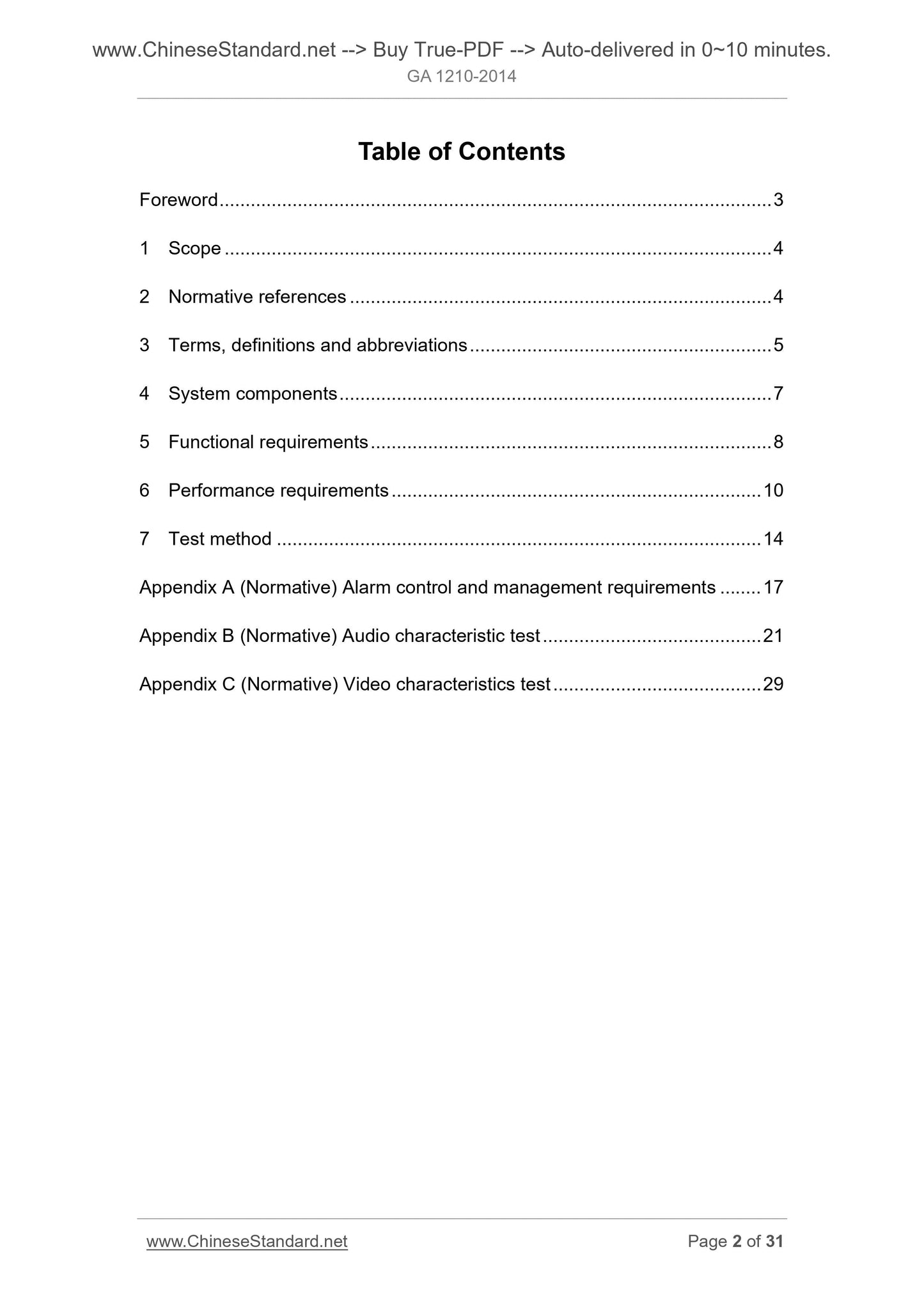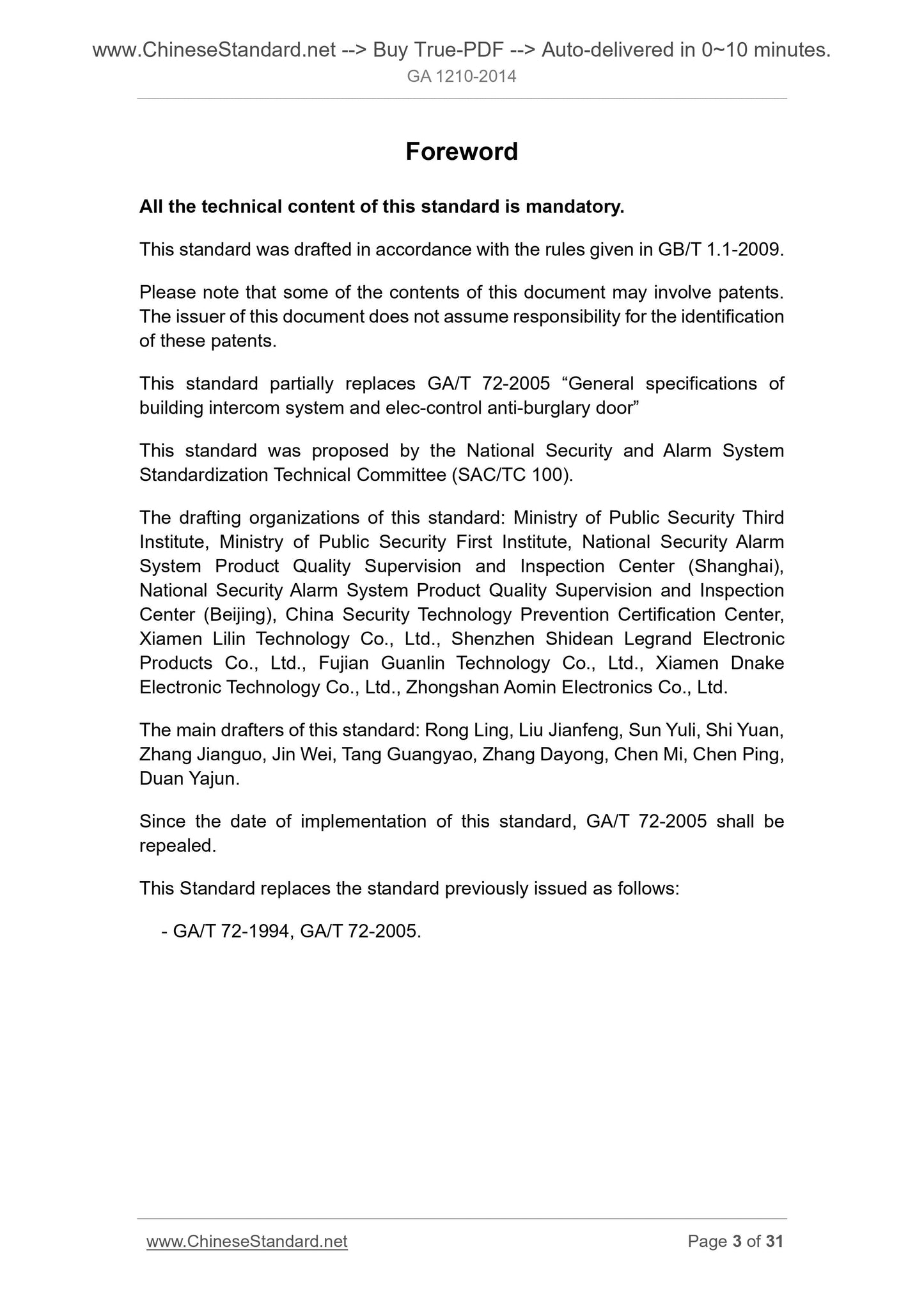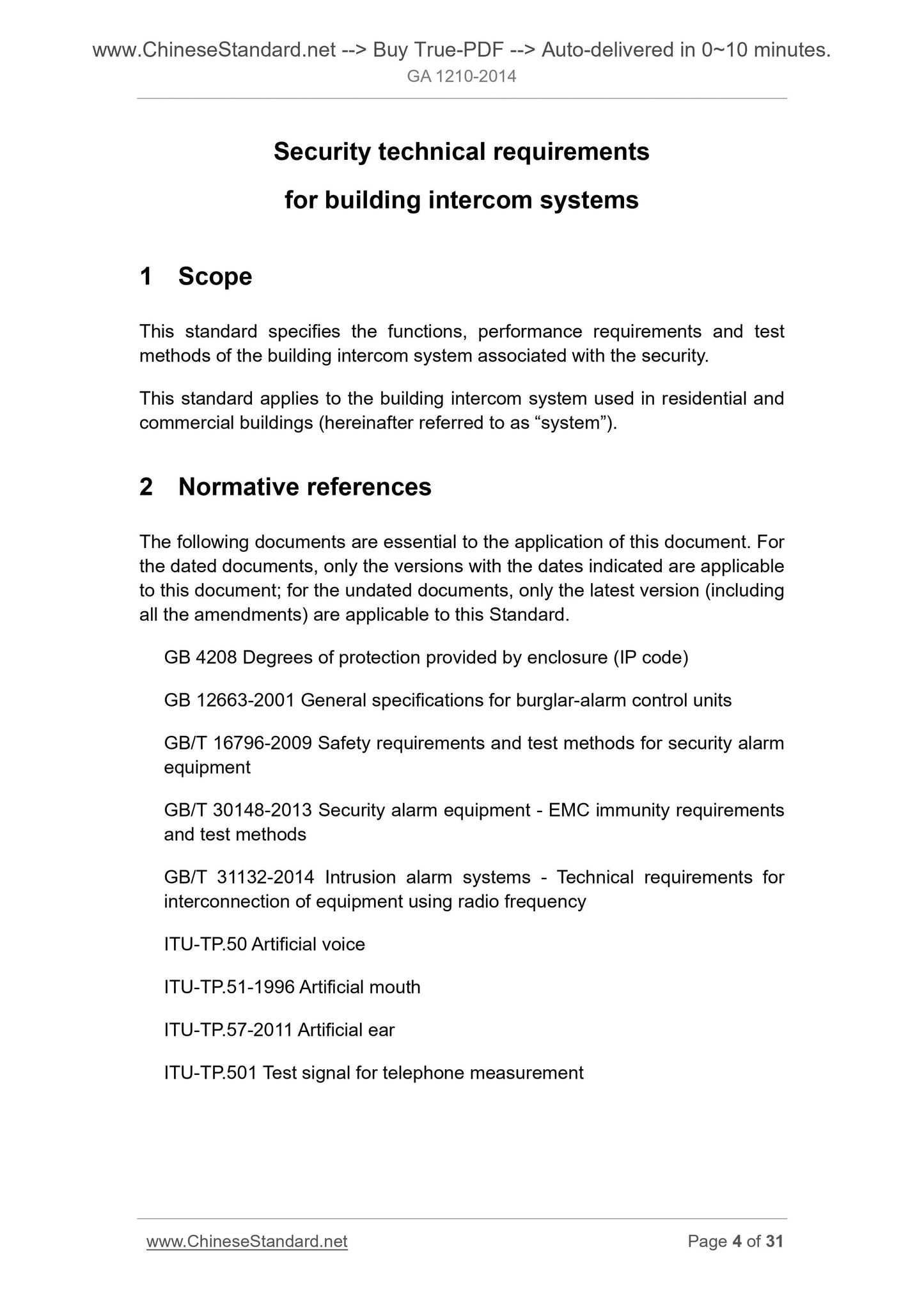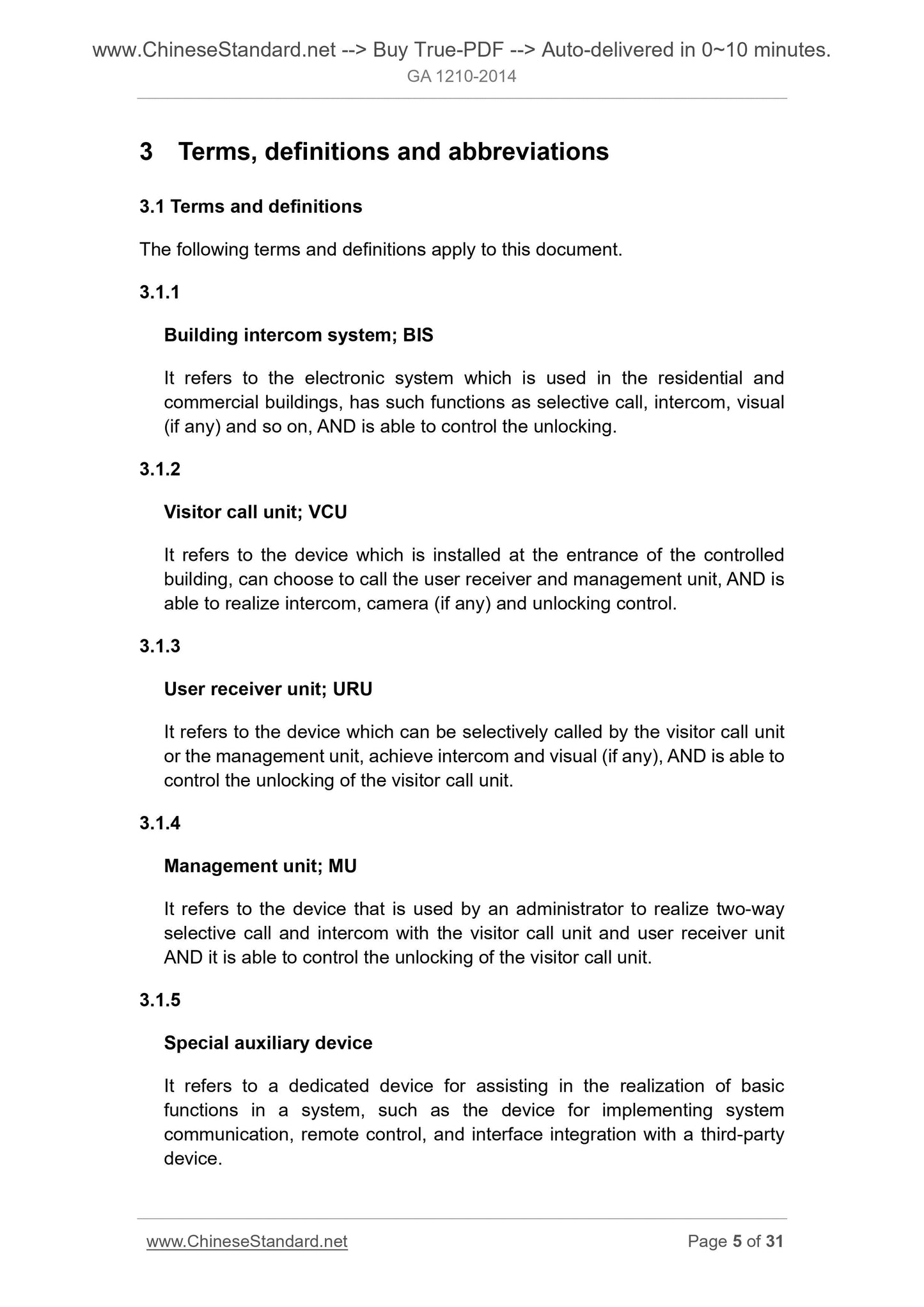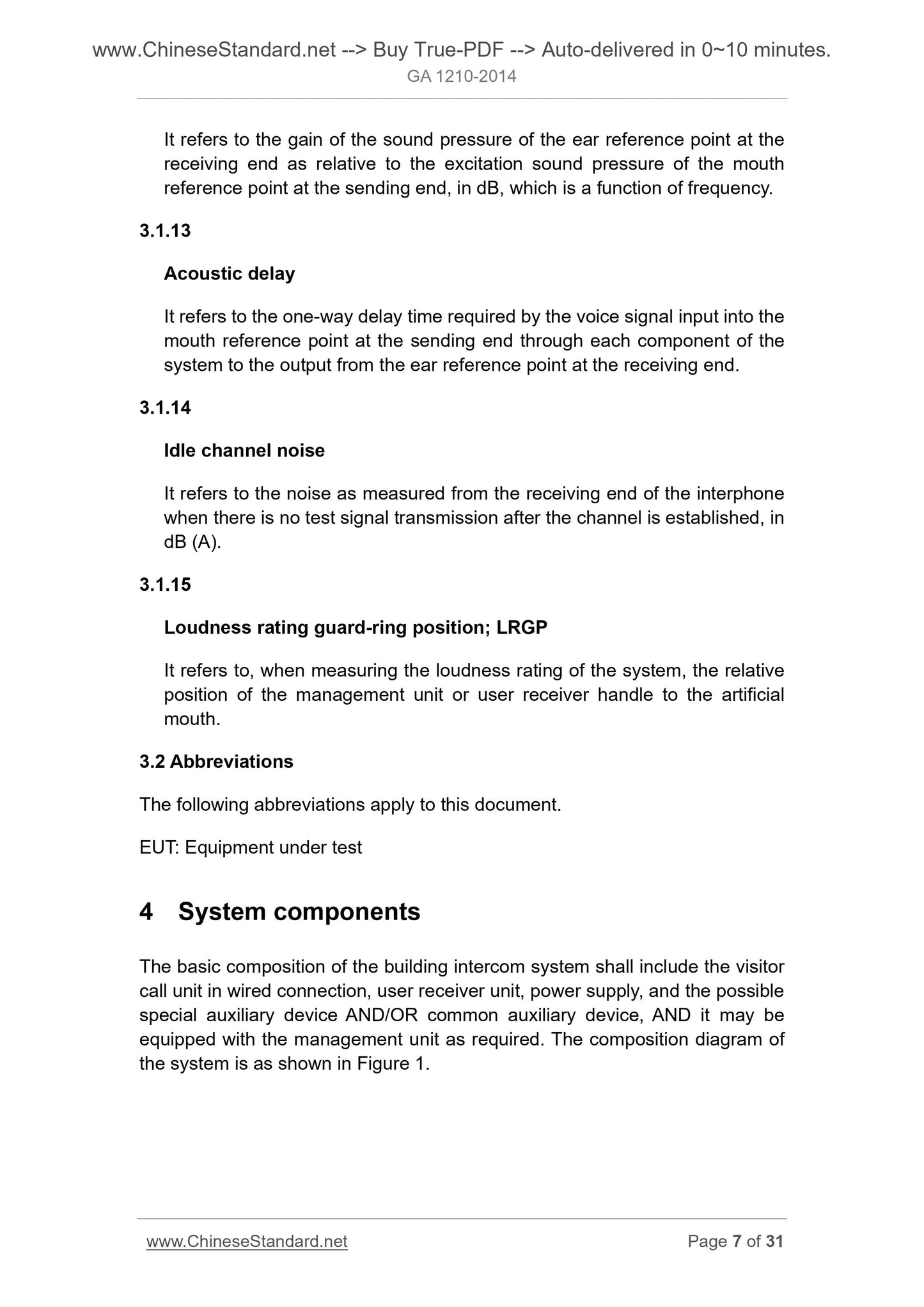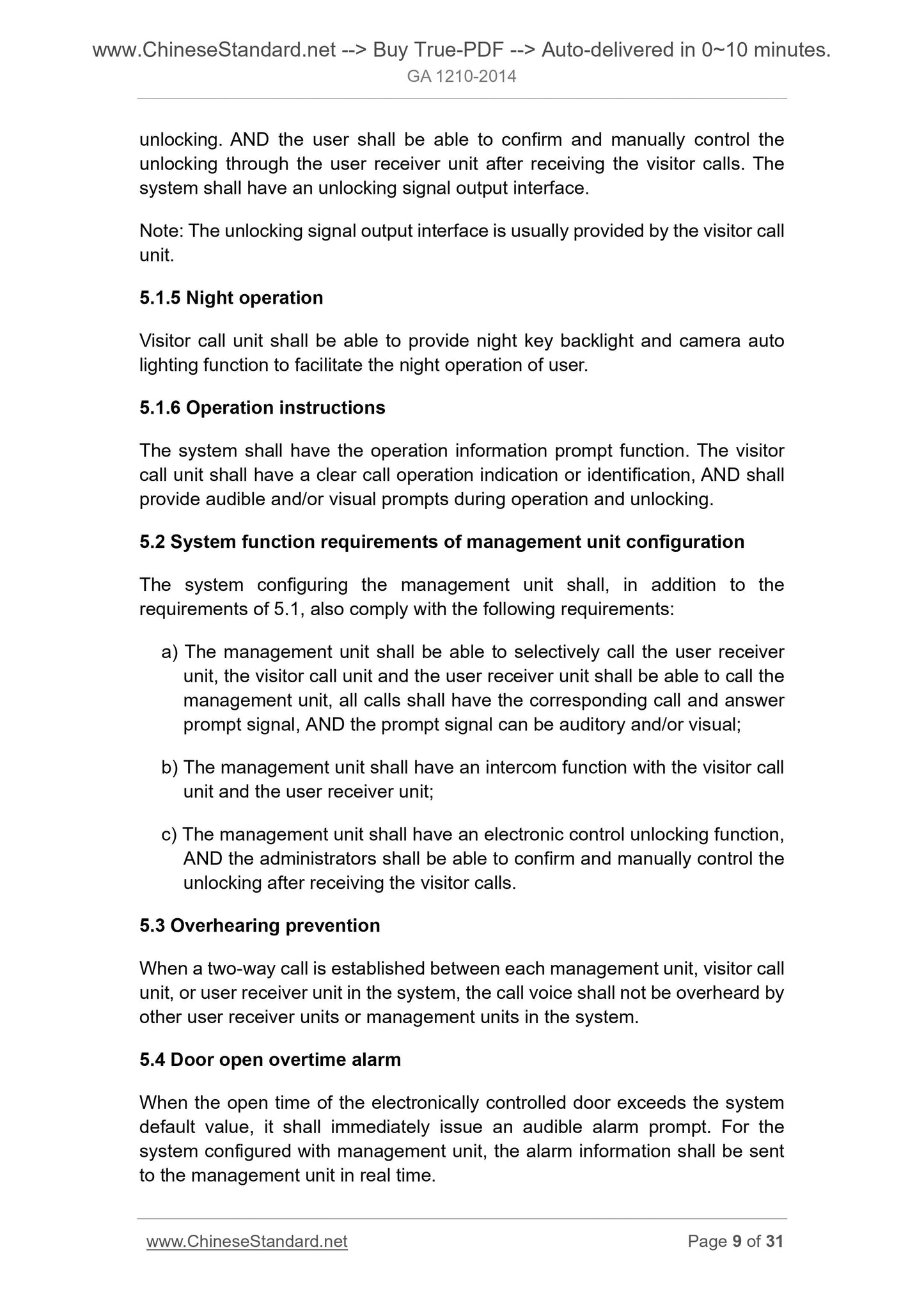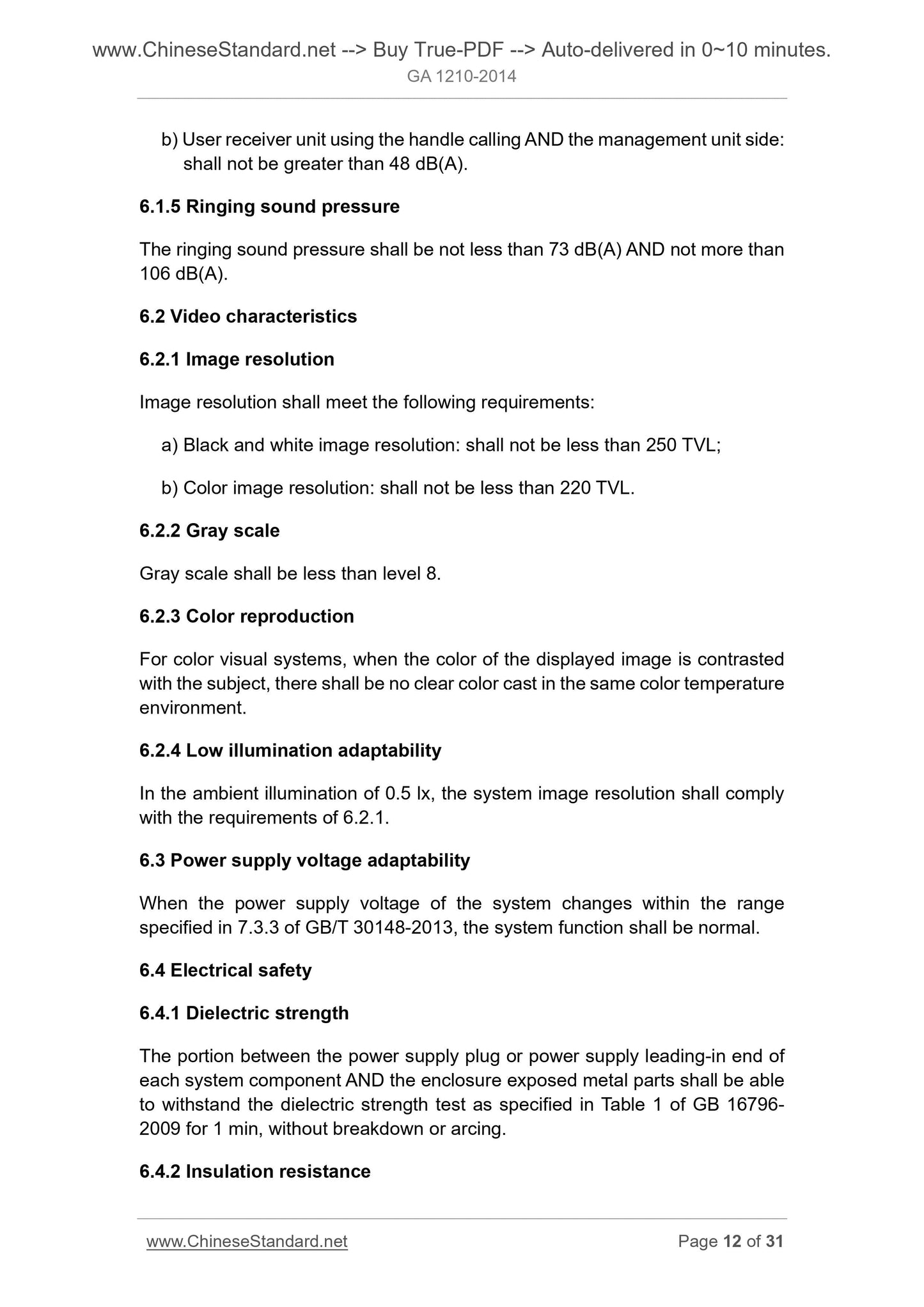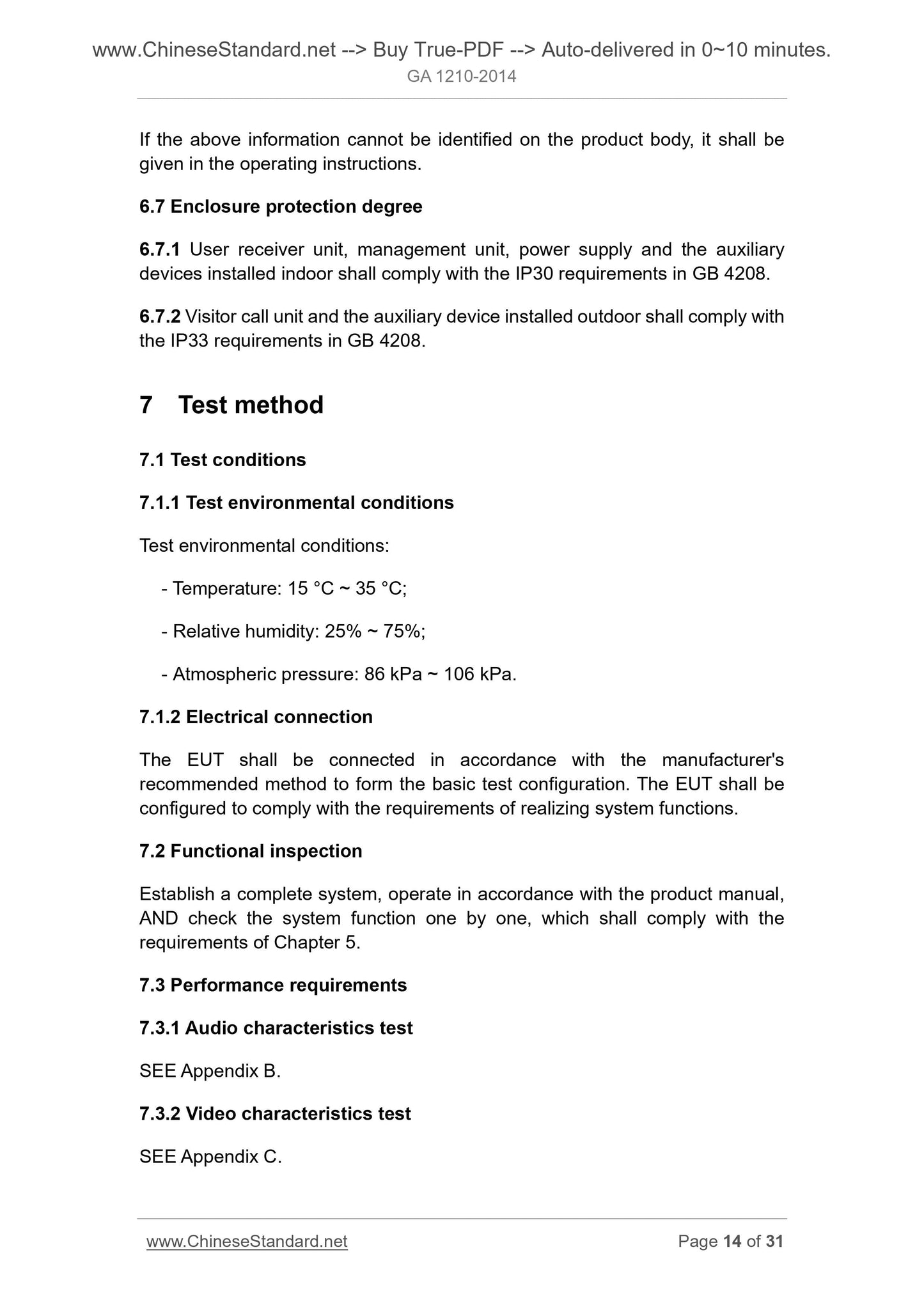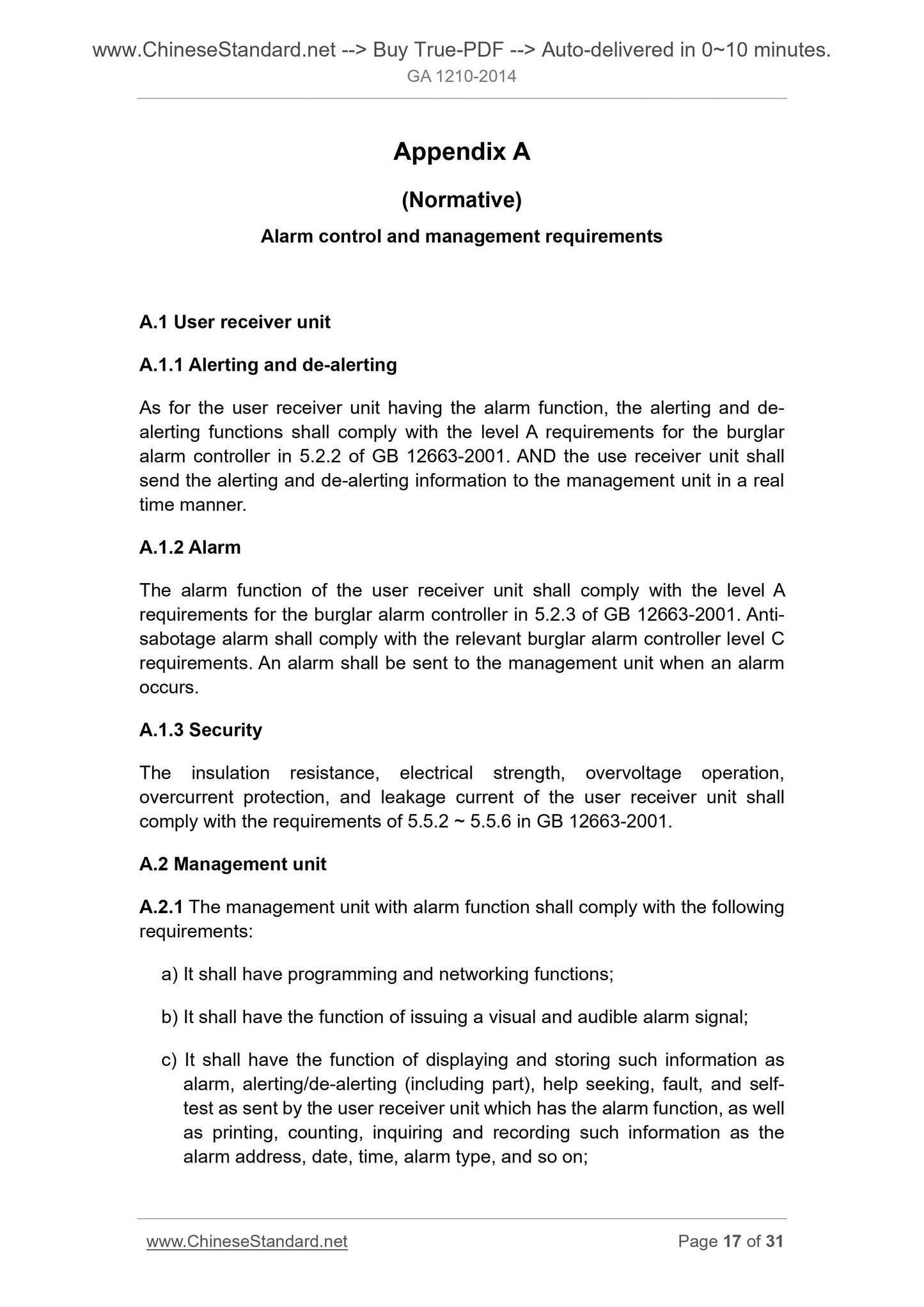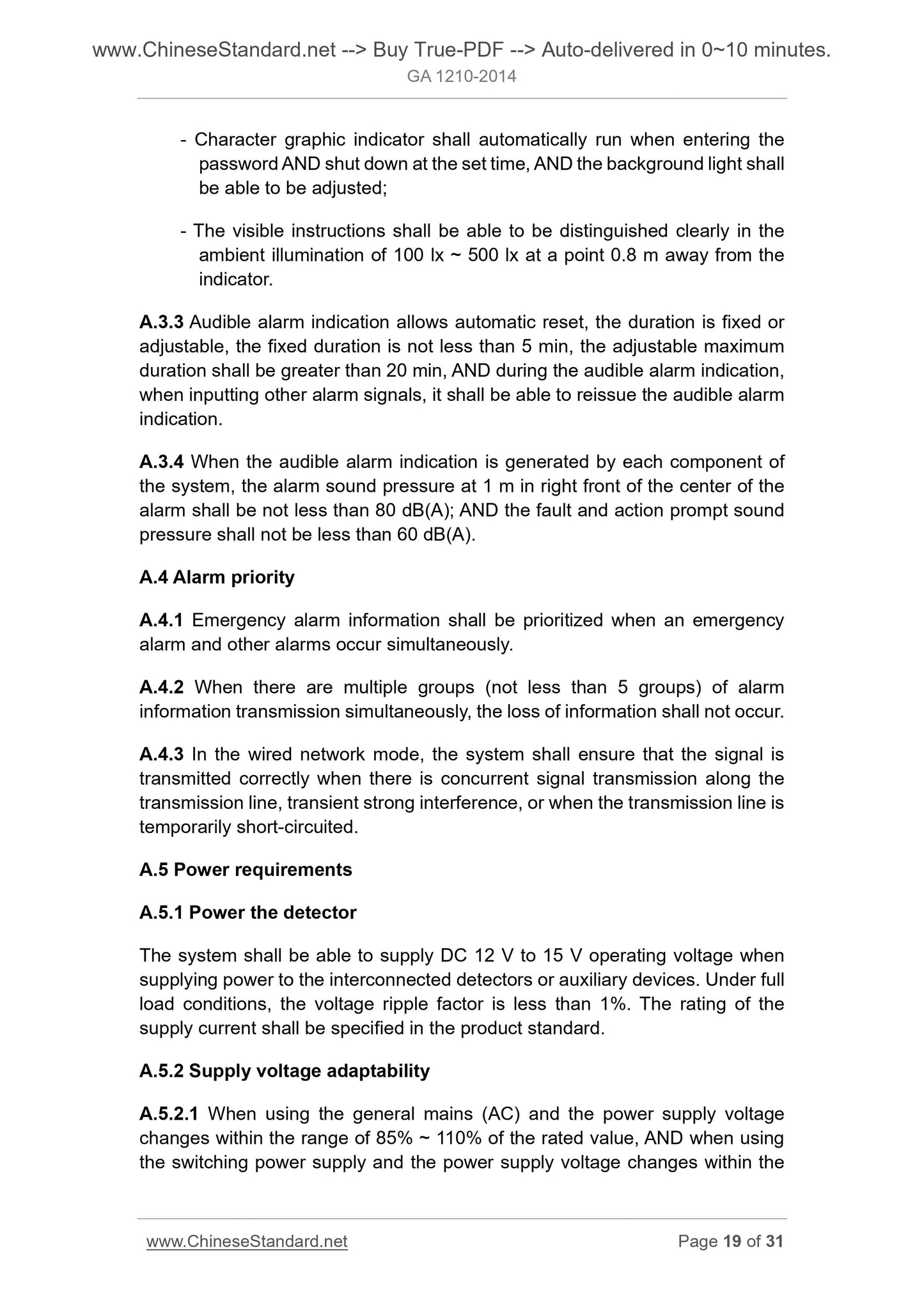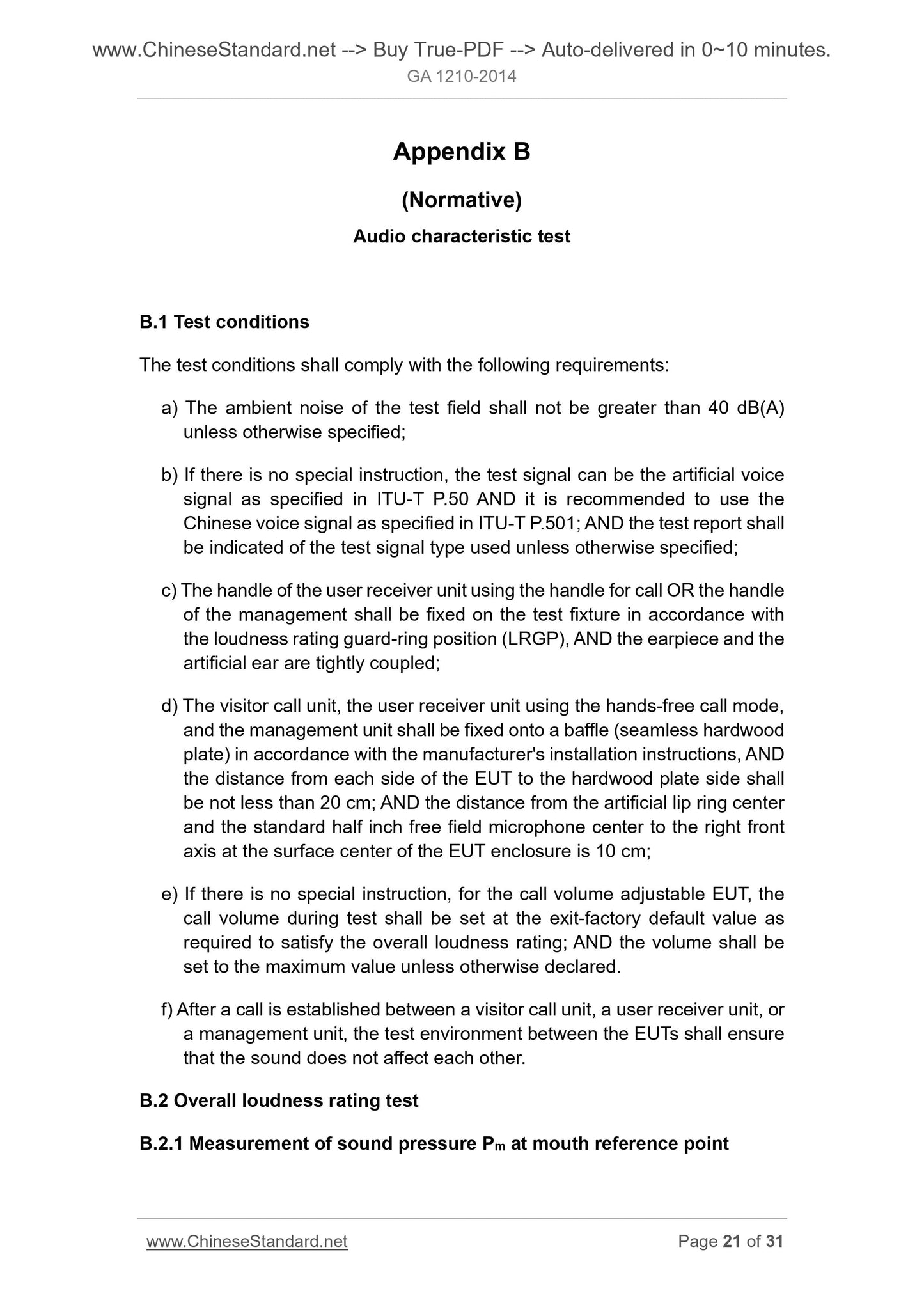1
/
of
12
PayPal, credit cards. Download editable-PDF and invoice in 1 second!
GA 1210-2014 English PDF (GA1210-2014)
GA 1210-2014 English PDF (GA1210-2014)
Regular price
$150.00 USD
Regular price
Sale price
$150.00 USD
Unit price
/
per
Shipping calculated at checkout.
Couldn't load pickup availability
Delivery: 3 seconds. Download true-PDF + Invoice.
Get QUOTATION in 1-minute: Click GA 1210-2014
Historical versions: GA 1210-2014
Preview True-PDF (Reload/Scroll if blank)
GA 1210-2014: Security technical requirements for building intercom systems
GA 1210-2014
GA
PUBLIC SECURITY INDUSTRY STANDARD
OF THE PEOPLE’S REPUBLIC OF CHINA
ICS 13.310
A 91
Partially replacing GA/T 72-2005
Security technical requirements
for building intercom systems
ISSUED ON. DECEMBER 23, 2014
IMPLEMENTED ON. JANUARY 01, 2015
Issued by. Ministry of Public Security of the People's Republic of China
3. No action is required - Full-copy of this standard will be automatically and
immediately delivered to your EMAIL address in 0~60 minutes.
Table of Contents
Foreword ... 3
1 Scope ... 4
2 Normative references ... 4
3 Terms, definitions and abbreviations ... 5
4 System components ... 7
5 Functional requirements ... 8
6 Performance requirements ... 10
7 Test method ... 14
Appendix A (Normative) Alarm control and management requirements ... 17
Appendix B (Normative) Audio characteristic test ... 21
Appendix C (Normative) Video characteristics test ... 29
Foreword
All the technical content of this standard is mandatory.
This standard was drafted in accordance with the rules given in GB/T 1.1-2009.
Please note that some of the contents of this document may involve patents.
The issuer of this document does not assume responsibility for the identification
of these patents.
This standard partially replaces GA/T 72-2005 “General specifications of
building intercom system and elec-control anti-burglary door”
This standard was proposed by the National Security and Alarm System
Standardization Technical Committee (SAC/TC 100).
The drafting organizations of this standard. Ministry of Public Security Third
Institute, Ministry of Public Security First Institute, National Security Alarm
System Product Quality Supervision and Inspection Center (Shanghai),
National Security Alarm System Product Quality Supervision and Inspection
Center (Beijing), China Security Technology Prevention Certification Center,
Xiamen Lilin Technology Co., Ltd., Shenzhen Shidean Legrand Electronic
Products Co., Ltd., Fujian Guanlin Technology Co., Ltd., Xiamen Dnake
Electronic Technology Co., Ltd., Zhongshan Aomin Electronics Co., Ltd.
The main drafters of this standard. Rong Ling, Liu Jianfeng, Sun Yuli, Shi Yuan,
Zhang Jianguo, Jin Wei, Tang Guangyao, Zhang Dayong, Chen Mi, Chen Ping,
Duan Yajun.
Since the date of implementation of this standard, GA/T 72-2005 shall be
repealed.
This Standard replaces the standard previously issued as follows.
- GA/T 72-1994, GA/T 72-2005.
Security technical requirements
for building intercom systems
1 Scope
This standard specifies the functions, performance requirements and test
methods of the building intercom system associated with the security.
This standard applies to the building intercom system used in residential and
commercial buildings (hereinafter referred to as “system”).
2 Normative references
The following documents are essential to the application of this document. For
the dated documents, only the versions with the dates indicated are applicable
to this document; for the undated documents, only the latest version (including
all the amendments) are applicable to this Standard.
GB 4208 Degrees of protection provided by enclosure (IP code)
GB 12663-2001 General specifications for burglar-alarm control units
GB/T 16796-2009 Safety requirements and test methods for security alarm
equipment
GB/T 30148-2013 Security alarm equipment - EMC immunity requirements
and test methods
GB/T 31132-2014 Intrusion alarm systems - Technical requirements for
interconnection of equipment using radio frequency
ITU-TP.50 Artificial voice
ITU-TP.51-1996 Artificial mouth
ITU-TP.57-2011 Artificial ear
ITU-TP.501 Test signal for telephone measurement
3 Terms, definitions and abbreviations
3.1 Terms and definitions
The following terms and definitions apply to this document.
3.1.1
Building intercom system; BIS
It refers to the electronic system which is used in the residential and
commercial buildings, has such functions as selective call, intercom, visual
(if any) and so on, AND is able to control the unlocking.
3.1.2
Visitor call unit; VCU
It refers to the device which is installed at the entrance of the controlled
building, can choose to call the user receiver and management unit, AND is
able to realize intercom, camera (if any) and unlocking control.
3.1.3
User receiver unit; URU
It refers to the device which can be selectively called by the visitor call unit
or the management unit, achieve intercom and visual (if any), AND is able to
control the unlocking of the visitor call unit.
3.1.4
Management unit; MU
It refers to the device that is used by an administrator to realize two-way
selective call and intercom with the visitor call unit and user receiver unit
AND it is able to control the unlocking of the visitor call unit.
3.1.5
Special auxiliary device
It refers to a dedicated device for assisting in the realization of basic
functions in a system, such as the device for implementing system
communication, remote control, and interface integration with a third-party
device.
It refers to the gain of the sound pressure of the ear reference point at the
receiving end as relative to the excitation sound pressure of the mouth
reference point at the sending end, in dB, which is a function of frequency.
3.1.13
Acoustic delay
It refers to the one-way delay time required by the voice signal input into the
mouth reference point at the sending end through each component of the
system to the output from the ear reference point at the receiving end.
3.1.14
Idle channel noise
It refers to the noise as measured from the receiving end of the interphone
when there is no test signal transmission after the channel is established, in
dB (A).
3.1.15
Loudness rating guard-ring position; LRGP
It refers to, when measuring the loudness rating of the system, the relative
position of the management unit or user receiver handle to the artificial
mouth.
3.2 Abbreviations
The following abbreviations apply to this document.
EUT. Equipment under test
4 System components
The basic composition of the building intercom system shall include the visitor
call unit in wired connection, user receiver unit, power supply, and the possible
special auxiliary device AND/OR common auxiliary device, AND it may be
equipped with the management unit as required. The composition diagram of
the system is as shown in Figure 1.
unlocking. AND the user shall be able to confirm and manually control the
unlocking through the user receiver unit after receiving the visitor calls. The
system shall have an unlocking signal output interface.
Note. The unlocking signal output interface is usually provided by the visitor call
unit.
5.1.5 Night operation
Visitor call unit shall be able to provide night key backlight and camera auto
lighting function to facilitate the night operation of user.
5.1.6 Operation instructions
The system shall have the operation information prompt function. The visitor
call unit shall have a clear call operation indication or identification, AND shall
provide audible and/or visual prompts during operation and unlocking.
5.2 System function requirements of management unit configuration
The system configuring the management unit shall, in addition to the
requirements of 5.1, also comply with the following requirements.
a) The management unit shall be able ...
Get QUOTATION in 1-minute: Click GA 1210-2014
Historical versions: GA 1210-2014
Preview True-PDF (Reload/Scroll if blank)
GA 1210-2014: Security technical requirements for building intercom systems
GA 1210-2014
GA
PUBLIC SECURITY INDUSTRY STANDARD
OF THE PEOPLE’S REPUBLIC OF CHINA
ICS 13.310
A 91
Partially replacing GA/T 72-2005
Security technical requirements
for building intercom systems
ISSUED ON. DECEMBER 23, 2014
IMPLEMENTED ON. JANUARY 01, 2015
Issued by. Ministry of Public Security of the People's Republic of China
3. No action is required - Full-copy of this standard will be automatically and
immediately delivered to your EMAIL address in 0~60 minutes.
Table of Contents
Foreword ... 3
1 Scope ... 4
2 Normative references ... 4
3 Terms, definitions and abbreviations ... 5
4 System components ... 7
5 Functional requirements ... 8
6 Performance requirements ... 10
7 Test method ... 14
Appendix A (Normative) Alarm control and management requirements ... 17
Appendix B (Normative) Audio characteristic test ... 21
Appendix C (Normative) Video characteristics test ... 29
Foreword
All the technical content of this standard is mandatory.
This standard was drafted in accordance with the rules given in GB/T 1.1-2009.
Please note that some of the contents of this document may involve patents.
The issuer of this document does not assume responsibility for the identification
of these patents.
This standard partially replaces GA/T 72-2005 “General specifications of
building intercom system and elec-control anti-burglary door”
This standard was proposed by the National Security and Alarm System
Standardization Technical Committee (SAC/TC 100).
The drafting organizations of this standard. Ministry of Public Security Third
Institute, Ministry of Public Security First Institute, National Security Alarm
System Product Quality Supervision and Inspection Center (Shanghai),
National Security Alarm System Product Quality Supervision and Inspection
Center (Beijing), China Security Technology Prevention Certification Center,
Xiamen Lilin Technology Co., Ltd., Shenzhen Shidean Legrand Electronic
Products Co., Ltd., Fujian Guanlin Technology Co., Ltd., Xiamen Dnake
Electronic Technology Co., Ltd., Zhongshan Aomin Electronics Co., Ltd.
The main drafters of this standard. Rong Ling, Liu Jianfeng, Sun Yuli, Shi Yuan,
Zhang Jianguo, Jin Wei, Tang Guangyao, Zhang Dayong, Chen Mi, Chen Ping,
Duan Yajun.
Since the date of implementation of this standard, GA/T 72-2005 shall be
repealed.
This Standard replaces the standard previously issued as follows.
- GA/T 72-1994, GA/T 72-2005.
Security technical requirements
for building intercom systems
1 Scope
This standard specifies the functions, performance requirements and test
methods of the building intercom system associated with the security.
This standard applies to the building intercom system used in residential and
commercial buildings (hereinafter referred to as “system”).
2 Normative references
The following documents are essential to the application of this document. For
the dated documents, only the versions with the dates indicated are applicable
to this document; for the undated documents, only the latest version (including
all the amendments) are applicable to this Standard.
GB 4208 Degrees of protection provided by enclosure (IP code)
GB 12663-2001 General specifications for burglar-alarm control units
GB/T 16796-2009 Safety requirements and test methods for security alarm
equipment
GB/T 30148-2013 Security alarm equipment - EMC immunity requirements
and test methods
GB/T 31132-2014 Intrusion alarm systems - Technical requirements for
interconnection of equipment using radio frequency
ITU-TP.50 Artificial voice
ITU-TP.51-1996 Artificial mouth
ITU-TP.57-2011 Artificial ear
ITU-TP.501 Test signal for telephone measurement
3 Terms, definitions and abbreviations
3.1 Terms and definitions
The following terms and definitions apply to this document.
3.1.1
Building intercom system; BIS
It refers to the electronic system which is used in the residential and
commercial buildings, has such functions as selective call, intercom, visual
(if any) and so on, AND is able to control the unlocking.
3.1.2
Visitor call unit; VCU
It refers to the device which is installed at the entrance of the controlled
building, can choose to call the user receiver and management unit, AND is
able to realize intercom, camera (if any) and unlocking control.
3.1.3
User receiver unit; URU
It refers to the device which can be selectively called by the visitor call unit
or the management unit, achieve intercom and visual (if any), AND is able to
control the unlocking of the visitor call unit.
3.1.4
Management unit; MU
It refers to the device that is used by an administrator to realize two-way
selective call and intercom with the visitor call unit and user receiver unit
AND it is able to control the unlocking of the visitor call unit.
3.1.5
Special auxiliary device
It refers to a dedicated device for assisting in the realization of basic
functions in a system, such as the device for implementing system
communication, remote control, and interface integration with a third-party
device.
It refers to the gain of the sound pressure of the ear reference point at the
receiving end as relative to the excitation sound pressure of the mouth
reference point at the sending end, in dB, which is a function of frequency.
3.1.13
Acoustic delay
It refers to the one-way delay time required by the voice signal input into the
mouth reference point at the sending end through each component of the
system to the output from the ear reference point at the receiving end.
3.1.14
Idle channel noise
It refers to the noise as measured from the receiving end of the interphone
when there is no test signal transmission after the channel is established, in
dB (A).
3.1.15
Loudness rating guard-ring position; LRGP
It refers to, when measuring the loudness rating of the system, the relative
position of the management unit or user receiver handle to the artificial
mouth.
3.2 Abbreviations
The following abbreviations apply to this document.
EUT. Equipment under test
4 System components
The basic composition of the building intercom system shall include the visitor
call unit in wired connection, user receiver unit, power supply, and the possible
special auxiliary device AND/OR common auxiliary device, AND it may be
equipped with the management unit as required. The composition diagram of
the system is as shown in Figure 1.
unlocking. AND the user shall be able to confirm and manually control the
unlocking through the user receiver unit after receiving the visitor calls. The
system shall have an unlocking signal output interface.
Note. The unlocking signal output interface is usually provided by the visitor call
unit.
5.1.5 Night operation
Visitor call unit shall be able to provide night key backlight and camera auto
lighting function to facilitate the night operation of user.
5.1.6 Operation instructions
The system shall have the operation information prompt function. The visitor
call unit shall have a clear call operation indication or identification, AND shall
provide audible and/or visual prompts during operation and unlocking.
5.2 System function requirements of management unit configuration
The system configuring the management unit shall, in addition to the
requirements of 5.1, also comply with the following requirements.
a) The management unit shall be able ...
Share
